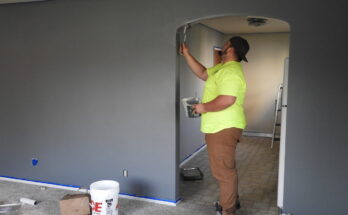Introduction
Embarking on a home improvement project can be both exciting and overwhelming. Whether you’re planning a small renovation or a major overhaul, understanding the terminology, materials, tools, and types of projects involved is crucial for success.
In this comprehensive guide, we’ll dive into the world of home improvement terms to help you navigate through your next DIY endeavor with confidence. Let’s get started!
Understanding the Basics of Home Improvement Terms
When delving into the world of home improvement, it’s essential to grasp the basics of terminology commonly used in the industry.
From understanding terms like “drywall” and “caulk” to knowing the difference between a “miter saw” and a “jigsaw,” familiarizing yourself with these terms will help you communicate effectively with contractors and suppliers.
Moreover, learning about terms such as “load-bearing wall,” “subfloor,” and “trimming” can provide valuable insights into the structural aspects of your home.
Knowing these terms will enable you to discuss your project requirements accurately and ensure that everyone involved is on the same page.
In addition, becoming familiar with common abbreviations like HVAC (Heating, Ventilation, and Air Conditioning) or DIY (Do It Yourself) can streamline communication and help you navigate through project plans more efficiently.
So, take some time to educate yourself on these fundamental home improvement terms before embarking on your next project!
Commonly Used Terminologies in Home Improvement

When embarking on a home improvement project, you may come across some common terminologies that are essential to understand.
One of the frequently used terms is “DIY,” which stands for do-it-yourself and refers to projects that homeowners tackle themselves without professional help.
Another term you might encounter is “HVAC,” which stands for heating, ventilation, and air conditioning systems. Understanding this term can help you navigate issues related to your home’s climate control efficiently.
“Backsplash” is another commonly used term in home improvement discussions, referring to the protective material installed behind sinks or stoves in kitchens or bathrooms.
It not only serves a practical purpose but also adds aesthetic value to the space.
Terms like “Caulk,” “Grout,” and “Primer” are often mentioned when discussing painting or tiling projects. Knowing these terms can help you communicate effectively with contractors or suppliers during your home improvement journey.
Materials and Tools Used in Home Improvement
When it comes to home improvement projects, having the right materials and tools is essential for a successful outcome.
From simple repairs to major renovations, different types of materials play a crucial role in achieving your desired results.
One of the most commonly used materials in home improvement is lumber. Whether you’re building a deck, framing walls, or installing shelves, having the right type and quality of wood can make all the difference.
Another key material is paint. Choosing the right color and finish can transform the look and feel of any room in your house. Don’t forget about brushes, rollers, and painter’s tape to ensure a clean and professional finish.
Tools are also vital for any home improvement project. Basic tools like hammers, screwdrivers, tape measures are must-haves for DIY enthusiasts.
Power tools such as drills, saws, and sanders can help speed up tasks and provide more precision.
Investing in high-quality materials and tools upfront can save you time and money in the long run while ensuring that your home improvement projects are done efficiently.
Types of Home Improvement Projects
When it comes to home improvement projects, the possibilities are endless. Whether you’re looking to spruce up your living space or increase your home’s value, there are various types of projects you can undertake.
One popular type of project is remodeling. This can include updating your kitchen, bathroom, or even adding a new room to your house.
Remodeling projects often involve changing the layout or design of a specific area in your home.
Another common project is renovation. Renovations typically focus on restoring or repairing existing features in your home, such as flooring, walls, or fixtures. This type of project can help give your home a fresh look without completely starting from scratch.
For those looking to enhance their outdoor space, landscaping and outdoor improvements are great options. From creating a beautiful garden to building a deck or patio, these projects can transform your backyard into an oasis for relaxation and entertainment.
No matter what type of home improvement project you choose, each one offers an opportunity to personalize and improve your living environment according to your preferences and needs.
Mistakes to Avoid in Home Improvement
Embarking on a home improvement project can be exciting, but it’s essential to be mindful of potential pitfalls along the way.
One common mistake is underestimating the time and effort required for a renovation. Be realistic with your timeline to avoid unnecessary stress.
Another mistake to avoid is cutting corners when it comes to materials. Opting for cheaper options may seem cost-effective initially, but could lead to more significant expenses in the long run if quality is compromised.
It’s crucial not to overlook proper planning and research before starting any project.
Rushing into decisions without fully understanding the scope of work can result in costly mistakes that could have been prevented with thorough preparation.
DIY enthusiasts should know their limits and recognize when a project requires professional expertise. Don’t hesitate to seek help from experienced professionals for tasks beyond your skill level.
By being aware of these potential missteps, you can navigate your home improvement journey with greater confidence and success.
Hiring a Professional for Home Improvement
When it comes to home improvement projects, hiring a professional can make all the difference. Professionals bring expertise and efficiency to the table, ensuring your project is completed with precision and care.
One of the key benefits of hiring a professional is their experience. They have likely encountered similar projects before and know how to navigate any challenges that may arise during the process.
Additionally, professionals often have access to specialized tools and materials that can elevate the quality of work done in your home. This ensures that the end result not only looks great but also stands the test of time.
While some may be tempted to take on DIY projects, hiring a professional can save you time and stress in the long run. Their skills and training enable them to work quickly without compromising on quality.
Investing in a professional for your home improvement needs can lead to a smoother process and superior results that you can enjoy for years to come.
Conclusion
As we wrap up our journey through the world of home improvement terms, it’s clear that knowledge is power when it comes to transforming your living space.
By understanding the basics and familiarizing yourself with common terminologies, you can confidently tackle various projects around your home.
Remember, the materials and tools used in home improvement play a crucial role in achieving successful results.
Whether you’re working on a small DIY project or a major renovation, having the right supplies at hand can make all the difference.
From simple repairs to full-scale remodels, there are countless types of home improvement projects to explore.
Each project offers its own set of challenges and rewards, so don’t be afraid to step out of your comfort zone and try something new.
Avoiding common mistakes in home improvement is essential for ensuring a smooth and stress-free process. Take your time, plan carefully, and always prioritize safety to minimize potential setbacks along the way.
And if you ever find yourself overwhelmed or unsure about a particular task, don’t hesitate to seek help from a professional. Working with experienced contractors can save you time, money, and headaches in the long run.
So keep learning, experimenting, and embracing the world of home improvement – your dream space awaits!
Q: How can I determine the budget for a home improvement project?
A: It’s essential to research the costs of materials and labor in your area, set priorities for the project, and be prepared for unexpected expenses.
Q: Should I hire a professional or DIY my home improvement project?
A: While some projects can be done DIY, it’s crucial to assess your skills and the complexity of the task. Hiring a professional ensures quality work and saves time and stress.
Q: What are some common mistakes to avoid in home improvement?
A: Some common mistakes include underestimating costs, not obtaining necessary permits, cutting corners on materials, and not planning ahead.
In this blog post, we have covered an array of essential topics related to home improvement terms. Understanding these basics will help you navigate through your next renovation or remodeling project with confidence. Whether you decide to tackle the improvements yourself or hire professionals, knowing these terms will ensure effective communication throughout the process. Happy renovating!










